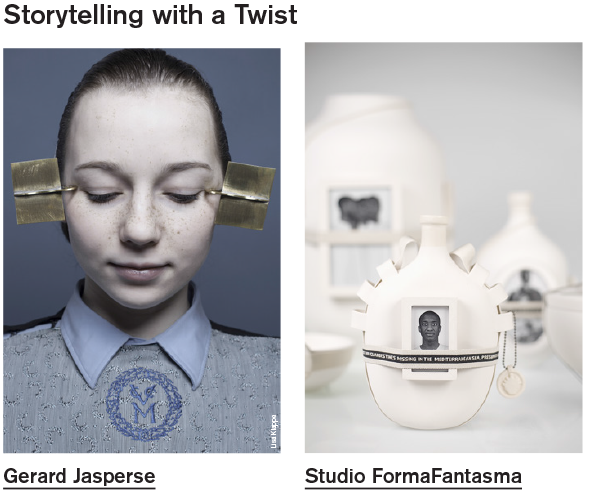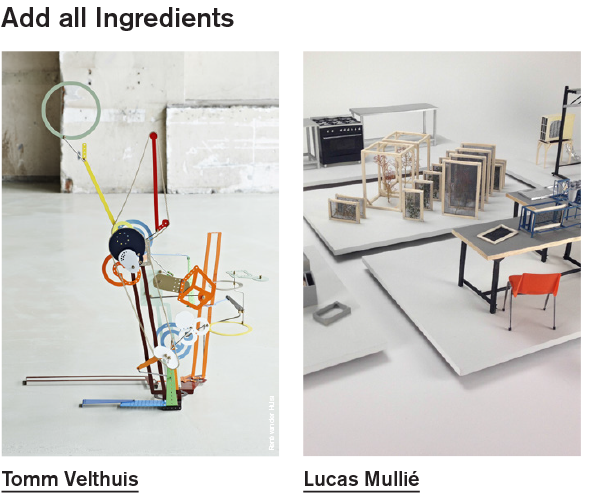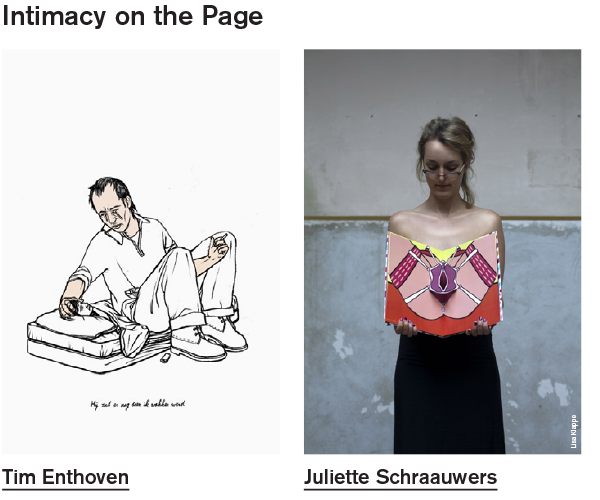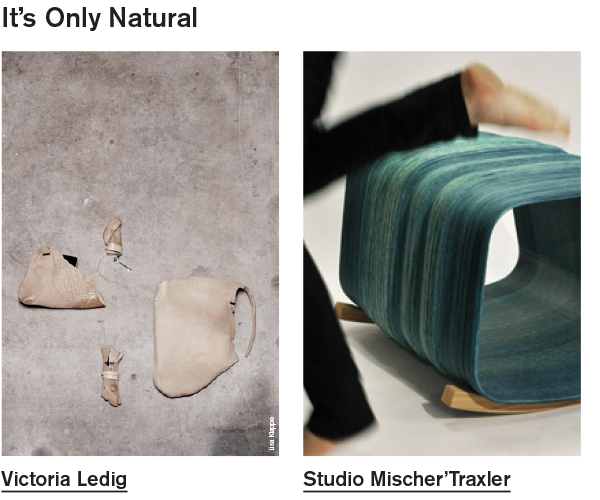
Ma’ayan Pesach
Food for Thought – The smell or taste of food can bring back old memories. Ma’ayan Pesach researched the link between nostalgia and food by interviewing people of different ages, backgrounds and beliefs. The most inspiring stories she compiled in her book ‘Food for Thought’. The publication presents a culinary collection of personal experiences, fantasies, rituals and recipes. Taking her cue from one of the stories, Ma’ayan examined the modern meat industry. Based on her findings, she designed a dinner set questioning the origins of the meat on our plates. Waste products such as bones, hair and skin are intuitively integrated into archetypical tableware.
maayanpesach.tumblr.com
Inge Kuipers
Tea Set Touch – Sitting down with a friend to have a cup of tea: it’s time to unwind. But for people with arthritis, pouring tea is not always so straightforward and self-evident, it can be quite an ordeal. Tools are available to help them, but these often have an unattractive, clinical look, highlighting the user’s disability and reducing their enjoyment. ‘Touch’ was developed not to look like a tool while offering all the advantages of one. It’s an innovative design that caters to all users and makes lifting, holding and pouring considerably easier. Because the set lacks handles every action necessarily becomes two-handed, which helps distribute the weight, avoid spilling and relieve any discomfort.
www.ingekuipers.nl

Dienke Dekker & Daniel Costa
The Symbiosis of Stoneware & Porcelain – Dienke Dekker and Daniel Costa researched stoneware and porcelain, two materials that complement each other well. By mixing, layering and combining them they gained a unique insight in their nature, both aesthetically and technically. As porcelain deforms more easily than stoneware, it adds an organic softness to the products. The tactile qualities of stoneware offset the porcelain smoothness. And the combination of the two materials makes for a subtle play of light. The result of this research is a three-dimensional ceramic portfolio; a playful system that explores the symbiotic interaction between the two materials and suggests possible uses for products and spaces.
www.dienkedekker.com
François Duquesnoy
Collectables – François Duquesnoy’s ongoing project explores an inexpensive, sustainable way of living nomadically. Surveying his new environment after having moved house once again, François noticed the heaps of discarded material everywhere. He decided to set himself a one week limit to gather waste materials and transform them into furniture for his new domicile. The short timeframe inspired a hands-on approach and a focus on creating rather than designing. So far François has made three series of furniture in three different cities. Each interior has been painted in one color, thus drawing attention to the final result and the potential of the materials rather than the materials themselves.
www.francoisduquesnoy.nl

Gerard Jasperse
On Sea & Land – The Province of Zeeland boasts a rich history in terms of trade and agriculture. This wealth has traditionally been reflected in the local population’s clothes and jewellery. While interesting in an aesthetic sense, these tokens of wealth also raise questions about their origin. Zeeland’s prosperity was largely based on the trans-Atlantic slave trade – a fact only half-heartedly acknowledged. On Sea & Land provides a missing link between historians and the public. It visualizes the more difficult aspects of Zeeland’s history using traditional local crafts, adding an extra layer to them and thus revitalizing them.
www.gerardjasperse.nl
Studio FormaFantasma
Moulding Tradition – The 17th century conquest of Sicily by Arabs from the Magreb inspired the production of ‘Teste di Moro’ vases, which are considered typical of Italian cultural heritage. While craftsmen still create these vases with African figures for the tourist market, people with similar features are entering the South of Italy, not as conquerors but as illegal immigrants. The majority of Italians considers these fugitives a danger to Italian culture. In Moulding Tradition Andrea Trimarchi and Simone Farresin question this ironic twist of history. The series of vessels and vases, which they created using both traditional and new techniques, refers to the changing nature of cultural heritage and the need to welcome this change.
www.formafantasma.com

Tomm Velthuis
Meccano 2.0 – In Meccano 2.0 Tomm Velthuis has ingeniously reinvented this century-old toy construction set. He contorted the sheet-metal parts into impossible shapes, retained the familiar drilled-hole pattern and painted them in bright primary colors. Unlike conventional Meccano pieces, there is no pre-conceived form or logical outcome. The shapes are intentionally impractical, unorthodox and ill-fitting. Inviting the creation of an infinite number of objects, the shapes act as tools to unlock the imagination. The project as a whole can be read as a commentary on outmoded ways of dealing with problems. It prompts users to think outside the predefined box.
www.bytomm.com
Lucas Mullié
The world of Foodcurators – In his graduation project ‘Tijdrestaurant’ (Time Restaurant) Lucas Mullié introduced the new profession of foodcurator - a hybrid between chef, designer and landscape architect. Tijdrestaurant was a temporary restaurant and no longer exists. But together with Digna Kosse and René Bosch Lucas has from 2011 onwards further defined the concept of foodcuratorship. The World of Foodcurators shows their interaction with food: collecting, conserving, processing and presenting. Time is always of the essence: how many minutes it takes to prepare a certain dish or how many years have to pass to mature a wine. In the process the foodcurators question the relationship between crafts and industry, and between nature and product.
foodcurators.wordpress.com

Tim Enthoven
Binnenskamers – Tim’s life hardly extends beyond his room. Its four walls form the boundaries within which he tries to create as much of a perspective as he can. Anything that could disturb his routine, he rejects. He deliberately shuts out a large part of the world. But will he be able to live with the things he has left? In his 96-page graphic novel Binnenskamers Tim Enthoven bypasses all conventions of comic books and literary novels. The result is a touching, surrealistic book about the life of a frightened boy who creates his own universe.
www.timenthoven.nl
Juliette Schraauwers
Fucked up?– At first glance, Juliette Schraauwers’ book is crude and coarse. But her satirical take on sex education is more than just a vulgar joke. The intentional shock value aims to provoke a discussion about the growing sexualization of our society and its effect on children and adolescents. Juliette’s project explicitely questions the unrestricted access to online pornography. It also points to the increasingly brutal and bizarre landscape of the contemporary porn industry, which is radically different from the glamorous nude photography in ‘Playboy’ thirty years ago. All this ultimately distorts children’s views on sex and relationships.
www.julietteschraauwers.nl

Victoria Ledig
Precious Skin – Leather is animal hide, but due to extensive processing it is often almost unrecognizable as such. Reminding us of the raw beauty of this natural material, Victoria Ledig’s collection of bags aims to reconnect the end product to the source material, highlighting its natural appeal. Victoria uses those body parts normally discarded by the leather industry such as cow’s heads and lower legs. Drawing inspiration from the naturally occurring shapes and textures she creates different elements, transforming a tail into a handle and an ear into a purse.
www.victorialedig.com
Studio Mischer’Traxler
The Idea of a Tree – In this project Katharina Mischer and Thomas Traxler have partly shed their usual role as designers. They have created a machine, but leave the outcome of production to solar energy. The intensity of the sun translates into one object a day. Each result reflects the sunshine conditions occurring during a specific day in a specific spot. Like a tree the object becomes a three-dimensional record of its process and time of creation. After their graduation both designers have continued to work on projects dealing with machines and the autonomy of the designer.
www.mischertraxler.com

Bart Eysink Smeets
A.A.D: Artificial Atmosphere Design – Bart Eysink Smeets is fascinated with everything fake. In A.A.D. he investigates what happens when people use fake items, lacking in character, to add character to their living environment. Taking the concept of fake to the extreme Bart has created a lifelike person out of plastic. When placed in a real-life context, such as by the side of a hospital bed or at the center of a birthday party, the fake man is more than just a creepy intruder. His being there raises questions about social situations and the impact of any presence, either fake or real.
www.a-a-d.nl
Gintare Cerniauskaite
EXO – Gintare Cerniauskaite’s Exo represents a perfect cross-over between design and healthcare. Her 3D-printed cast heals broken bones faster than a traditional plaster cast. Because of its open, waterproof and removable structure, it enables the patient to commence physiotherapy immediately, which significantly shortens the healing time and prevents complications. EXO is made of a strong, lightweight plastic that can be made to fit every individual patient. The look can be customized choosing a particular pattern and color. When the cast is removed in four to six weeks, there is no need for further treatment. After shredding, the recycled material can be used for new casts.
www.gintarecer.eu